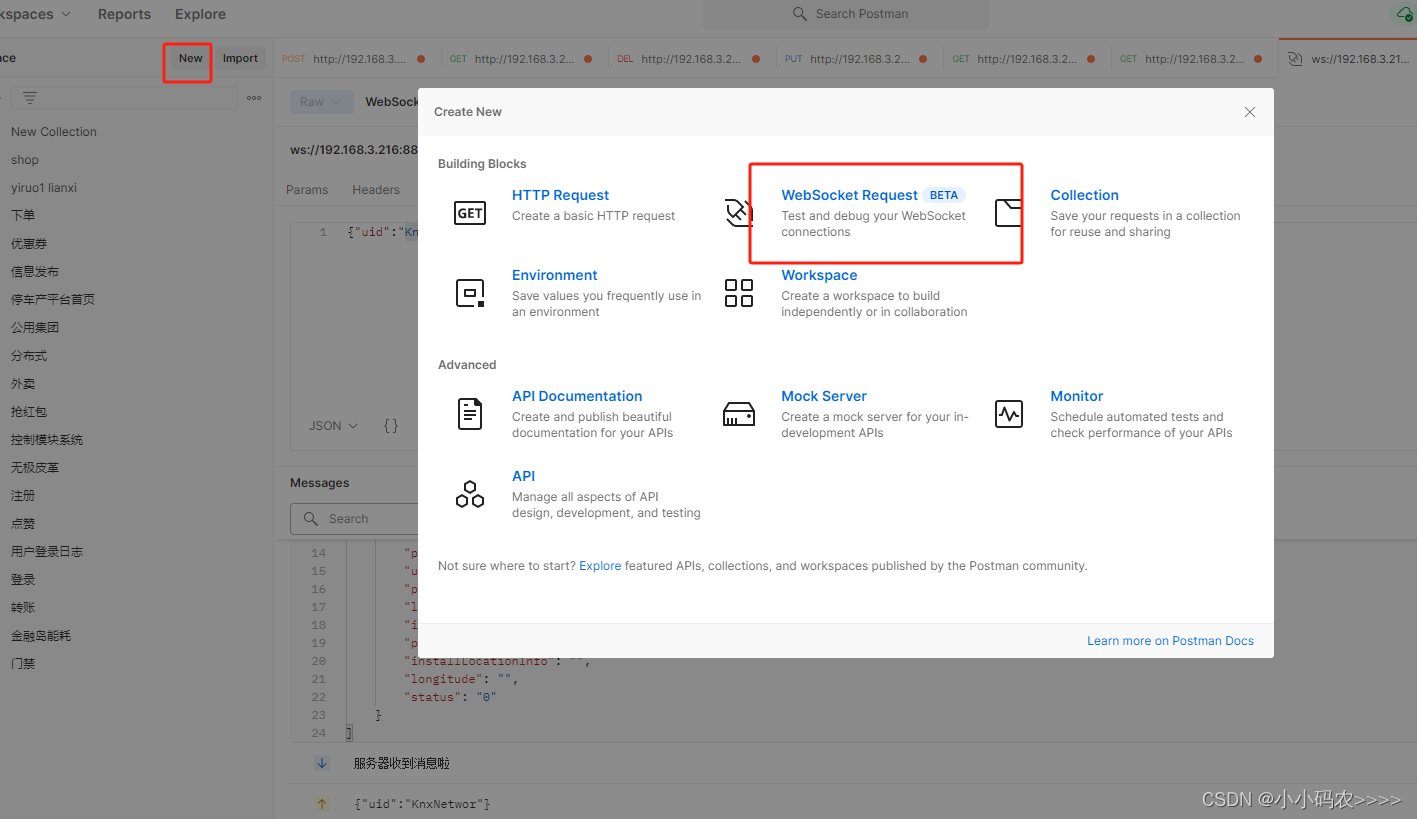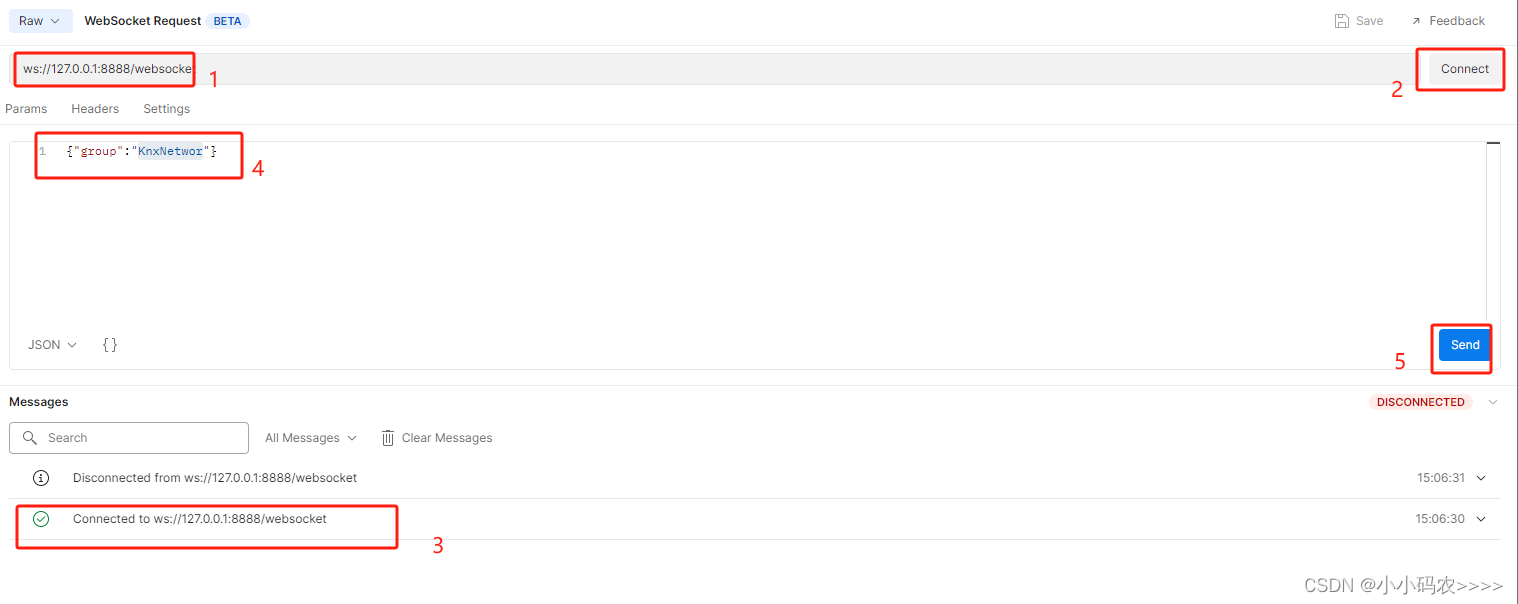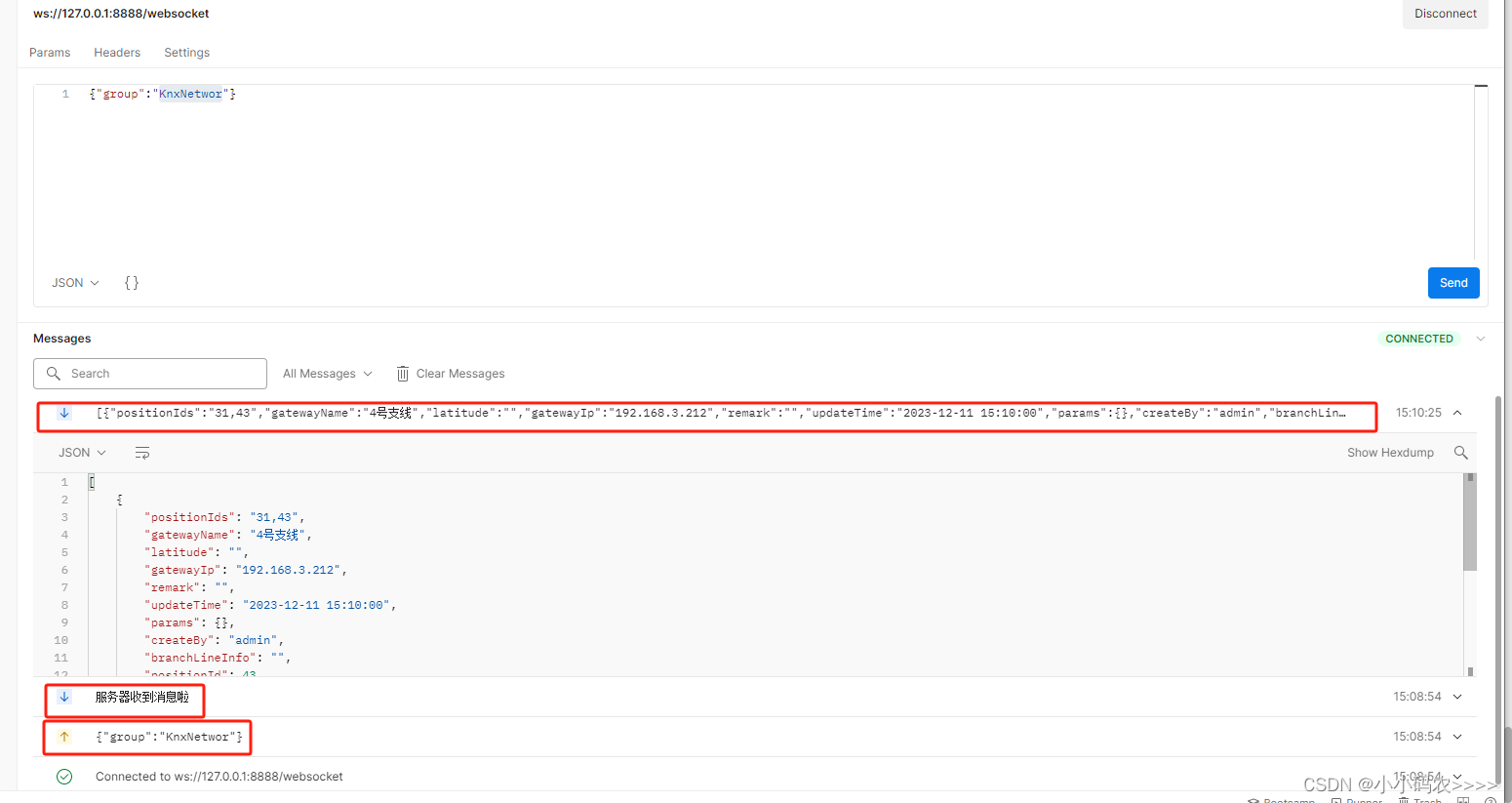SpringBoot+Netty+Websocket实现消息推送
发布时间:2023年12月17日
这样一个需求:把设备异常的状态每10秒推送到页面并且以弹窗弹出来,这个时候用Websocket最为合适,今天主要是后端代码展示。
添加依赖
<dependency>
<groupId>io.netty</groupId>
<artifactId>netty-all</artifactId>
<version>4.1.36.Final</version>
</dependency>
<dependency>
<groupId>org.springframework.boot</groupId>
<artifactId>spring-boot-starter-websocket</artifactId>
</dependency>
定义netty端口号
websocket:
netty:
port: 8888
path: /websocket
netty服务器
@Slf4j
@Component
public class NettyServer {
/**
* netty服务端口号
*/
@Value("${websocket.netty.port}")
private int port;
/**
* netty事件辅助组
*/
private EventLoopGroup bossGroup;
/**
* netty事件工作组
*/
private EventLoopGroup workGroup;
/**
* 管道配置
*/
private final CustomChannelInitializer channelInitializer;
public NettyServer(CustomChannelInitializer channelInitializer) {
this.channelInitializer = channelInitializer;
}
/**
* netty服务初始化
*/
@PostConstruct
public void start() {
new Thread(() -> {
bossGroup = new NioEventLoopGroup();
workGroup = new NioEventLoopGroup();
ServerBootstrap bootstrap = new ServerBootstrap();
//bossGroup辅助客户端的tcp连接请求, workGroup负责与客户端之前的读写操作
bootstrap.group(bossGroup, workGroup);
//设置NIO类型的channel
bootstrap.channel(NioServerSocketChannel.class);
//设置监听端口
bootstrap.localAddress(new InetSocketAddress(port));
//设置管道
bootstrap.childHandler(channelInitializer);
try {
ChannelFuture channelFuture = bootstrap.bind().sync();
log.info("Netty服务启动成功,开启监听:{}", channelFuture.channel().localAddress());
//对关闭通道进行监听
channelFuture.channel().closeFuture().sync();
} catch (InterruptedException e) {
log.error("Netty服务启动失败!", e);
throw new RuntimeException(e);
}
}).start();
}
}
Netty配置
管理全局Channel以及用户对应的channel(推送消息)
import io.netty.channel.Channel;
import io.netty.channel.group.ChannelGroup;
import io.netty.channel.group.DefaultChannelGroup;
import io.netty.util.concurrent.GlobalEventExecutor;
import java.util.concurrent.ConcurrentHashMap;
/**
* @version 1.0.0
* @description 业务类
*/
public class NettyConfig {
/**
* 定义全局单利channel组 管理所有channel
*/
private static volatile ChannelGroup channelGroup = null;
/**
* 存放请求ID与channel的对应关系
*/
private static volatile ConcurrentHashMap<String, Channel> channelMap = null;
/**
* 定义两把锁
*/
private static final Object lock1 = new Object();
private static final Object lock2 = new Object();
public static ChannelGroup getChannelGroup() {
if (null == channelGroup) {
synchronized (lock1) {
if (null == channelGroup) {
channelGroup = new DefaultChannelGroup(GlobalEventExecutor.INSTANCE);
}
}
}
return channelGroup;
}
public static ConcurrentHashMap<String, Channel> getChannelMap() {
if (null == channelMap) {
synchronized (lock2) {
if (null == channelMap) {
channelMap = new ConcurrentHashMap<>();
}
}
}
return channelMap;
}
public static Channel getChannel(String userId) {
if (null == channelMap) {
return getChannelMap().get(userId);
}
return channelMap.get(userId);
}
}
管道配置
import io.netty.channel.ChannelInitializer;
import io.netty.channel.ChannelPipeline;
import io.netty.channel.socket.SocketChannel;
import io.netty.handler.codec.http.HttpObjectAggregator;
import io.netty.handler.codec.http.HttpServerCodec;
import io.netty.handler.codec.http.websocketx.WebSocketServerProtocolHandler;
import io.netty.handler.codec.serialization.ObjectEncoder;
import io.netty.handler.stream.ChunkedWriteHandler;
import org.springframework.beans.factory.annotation.Value;
import org.springframework.stereotype.Component;
/**
* @version 1.0.0
* @description Netty管道配置类
*/
@Component
public class CustomChannelInitializer extends ChannelInitializer<SocketChannel> {
/**
* webSocket协议名
*/
private static final String WEBSOCKET_PROTOCOL = "WebSocket";
/**
* websocket服务地址
*/
@Value("${websocket.path:/websocket}")
private String websocketPath;
private final CustomChannelHandler channelHandler;
public CustomChannelInitializer(CustomChannelHandler channelHandler) {
this.channelHandler = channelHandler;
}
@Override
protected void initChannel(SocketChannel socketChannel) throws Exception {
// 设置管道
ChannelPipeline pipeline = socketChannel.pipeline();
// 流水线管理通道中的处理程序(Handler),用来处理业务
// webSocket协议本身是基于http协议的,所以这边也要使用http编解码器
pipeline.addLast(new HttpServerCodec());
pipeline.addLast(new ObjectEncoder());
// 以块的方式来写的处理器
pipeline.addLast(new ChunkedWriteHandler());
pipeline.addLast(new HttpObjectAggregator(8192));
pipeline.addLast(new WebSocketServerProtocolHandler(websocketPath, WEBSOCKET_PROTOCOL, true, 65536 * 10));
// 自定义的handler,处理业务逻辑
pipeline.addLast(channelHandler);
}
}
自定义CustomChannelHandler
import cn.hutool.json.JSONObject;
import cn.hutool.json.JSONUtil;
import com.ruoyi.common.utils.StringUtils;
import io.netty.channel.ChannelHandler;
import io.netty.channel.ChannelHandlerContext;
import io.netty.channel.SimpleChannelInboundHandler;
import io.netty.handler.codec.http.websocketx.TextWebSocketFrame;
import io.netty.util.AttributeKey;
import lombok.extern.slf4j.Slf4j;
import org.springframework.stereotype.Component;
/**
* @version 1.0.0
* @description Netty管道handler类
*/
@Slf4j
@Component
@ChannelHandler.Sharable
public class CustomChannelHandler extends SimpleChannelInboundHandler<TextWebSocketFrame> {
/**
* 一旦连接,第一个被执行
*/
@Override
public void handlerAdded(ChannelHandlerContext ctx) throws Exception {
log.info("有新的客户端链接:[{}]", ctx.channel().id().asLongText());
// 添加到channelGroup 通道组
NettyConfig.getChannelGroup().add(ctx.channel());
}
/**
* 读取数据
*/
@Override
protected void channelRead0(ChannelHandlerContext ctx, TextWebSocketFrame msg) throws Exception {
log.info("服务器收到消息:{}", msg.text());
// 获取用户ID,关联channel
JSONObject jsonObject = JSONUtil.parseObj(msg.text());
String uid = jsonObject.getStr("uid");
if(StringUtils.isNotEmpty(uid)){
NettyConfig.getChannelMap().put(uid, ctx.channel());
// 将用户ID作为自定义属性加入到channel中,方便随时channel中获取用户ID
AttributeKey<String> key = AttributeKey.valueOf("userId");
ctx.channel().attr(key).setIfAbsent(uid);
// 回复消息
ctx.channel().writeAndFlush(new TextWebSocketFrame("服务器收到消息啦"));
}
}
@Override
public void handlerRemoved(ChannelHandlerContext ctx) throws Exception {
log.info("用户下线了:{}", ctx.channel().id().asLongText());
// 删除通道
NettyConfig.getChannelGroup().remove(ctx.channel());
removeUserId(ctx);
}
@Override
public void exceptionCaught(ChannelHandlerContext ctx, Throwable cause) throws Exception {
log.info("异常:{}", cause.getMessage());
super.exceptionCaught(ctx,cause);
// 删除通道
NettyConfig.getChannelGroup().remove(ctx.channel());
removeUserId(ctx);
ctx.close();
}
/**
* 删除用户与channel的对应关系
*/
private void removeUserId(ChannelHandlerContext ctx) {
AttributeKey<String> key = AttributeKey.valueOf("userId");
String userId = ctx.channel().attr(key).get();
if(StringUtils.isNotEmpty(userId)){
NettyConfig.getChannelMap().remove(userId);
}
}
}
推送消息接口及实现类
public interface PushMsgService {
/**
* 推送给指定用户
*/
void pushMsgToOne(String group, String msg);
/**
* 推送给所有用户
*/
void pushMsgToAll(String msg);
}
实现接口
@Service
public class PushMsgServiceImpl implements PushMsgService {
@Override
public void pushMsgToOne(String group, String msg) {
Channel channel = NettyConfig.getChannel(group);
if (Objects.isNull(channel)) {
throw new RuntimeException("未连接socket服务器");
}
channel.writeAndFlush(new TextWebSocketFrame(msg));
}
@Override
public void pushMsgToAll(String msg) {
NettyConfig.getChannelGroup().writeAndFlush(new TextWebSocketFrame(msg));
}
}
具体的controller层接口
/**
* 获取弹框网关状态
*/
@GetMapping("/upKnxNetworkLink/{uid}")
public void upKnxNetworkLink(@PathVariable String uid){
KnxNetworkLinkInfo knxNetworkLinkInfo =new KnxNetworkLinkInfo();
knxNetworkLinkInfo.setStatus("0");
List<KnxNetworkLinkInfo>knxNetworkLinkInfoList=knxNetworkLinkInfoService.queryList(knxNetworkLinkInfo);
JSONArray array= JSONArray.parseArray(JSON.toJSONString(knxNetworkLinkInfoList));
pushMsgService.pushMsgToOne(uid,array.toJSONString());
}
使用postman测试Websocket推送

连接Websocket

在开一个窗口测试发送消息的接口

发送过后在回到连接Websocket窗口

前端需要做一个定时访问发送消息的接口,每发一次就会往前端推送一次数据。
参考:Springboot + netty +websocket 实现推送消息
文章来源:https://blog.csdn.net/weixin_44831330/article/details/134927068
本文来自互联网用户投稿,该文观点仅代表作者本人,不代表本站立场。本站仅提供信息存储空间服务,不拥有所有权,不承担相关法律责任。 如若内容造成侵权/违法违规/事实不符,请联系我的编程经验分享网邮箱:chenni525@qq.com进行投诉反馈,一经查实,立即删除!
本文来自互联网用户投稿,该文观点仅代表作者本人,不代表本站立场。本站仅提供信息存储空间服务,不拥有所有权,不承担相关法律责任。 如若内容造成侵权/违法违规/事实不符,请联系我的编程经验分享网邮箱:chenni525@qq.com进行投诉反馈,一经查实,立即删除!
最新文章
- Python教程
- 深入理解 MySQL 中的 HAVING 关键字和聚合函数
- Qt之QChar编码(1)
- MyBatis入门基础篇
- 用Python脚本实现FFmpeg批量转换
- 走进中国人民大学与加拿大女王大学金融硕士项目,抓住人生新机会!
- IJTAG
- C语言:编译和链接
- Nginx 文件名逻辑漏洞(CVE-2013-4547)
- 如何创建一个pytorch的训练数据加载器(train_loader)用于批量加载训练数据
- mysql用同一张表中的一个字段更新另外一个字段
- SpringMVC数据传递及数据处理
- Python中字典合并的七种方法全集
- npm发布js工具包
- 【基于k8s集群的MySQL部署】